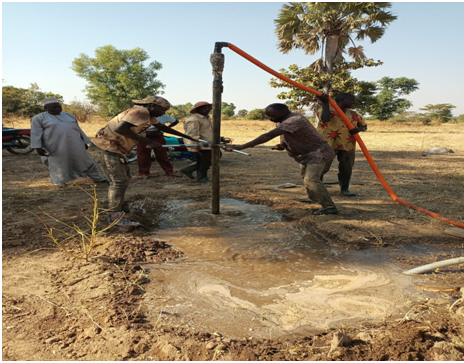In the heart of rural communities, a transformation is taking root – one that empowers farmers and cultivates sustainable growth. Community-based irrigation projects are emerging as beacons of change, bringing local wisdom, collaboration, and innovation together to shape the future of agriculture.

"Innovation is our greatest tool. Just as we've revolutionized technology, let's revolutionize irrigation. Efficient water use is not just a solution; it's our responsibility."- Bill Gates.
Agriculture uses about 70 percent of the world’s fresh water. Shortages and changes in water availability pose significant challenges to food security. They affect growing seasons, pests and crop productivity, hindering farmers’ ability to produce food for a growing population.
At cozance we adopt conservation agriculture practices, which helps us optimize water use, increase soil water holding capacity, reduce water runoff and build crop resilience to changing weather patterns. We measure what can be achieved on farms through our Good Growth Plan.
This article explores the significance of these projects in empowering farmers for sustainable growth, weaving a narrative of resilience, community spirit, and environmental stewardship.
Section 1: Cultivating Community Empowerment
This concept gives farmers and other stakeholders in the community more control over their agricultural future. Instead of letting each farmer battle the elements on their own, governments and private sectors bring together the entire agricultural community to establish systematic and sustainable irrigation practices
Section 2: The Ripple Effect of Local Resource Management
The sustainable use of water resources is a crucial aspect of community-based irrigation projects. It is essential to ensure that the water resources are used efficiently and effectively to meet the needs of the community while preserving the environment. According to the World Bank, sustainable irrigation projects can be developed through public-private partnerships (PPP).
Water is a precious resource, and its conservation is essential for long-term agricultural sustainability. There are several water-saving techniques and efficient management practices that can be employed to achieve this goal. Some of these practices include:
Soil health practice: Soil health practices such as crop rotation, cover cropping, and reduced tillage can help improve soil structure, increase water-holding capacity, and reduce soil erosion
i. Irrigation methods: Efficient irrigation methods such as drip irrigation, micro-sprinklers, and subsurface irrigation can help reduce water usage by up to 50% compared to traditional flood irrigation methods
ii. Water harvesting: Water harvesting techniques such as rainwater harvesting, runoff harvesting, and fog harvesting can help capture and store water for later use
iii. Steep and slope management: Steep and slope management practices such as terracing, contour farming, and grassed waterways can help reduce soil erosion and increase water infiltration
iv. Precision agriculture: Precision agriculture techniques such as variable rate irrigation, soil moisture sensors, and remote sensing can help optimize water usage and reduce waste.
Wastewater management practices such as reuse and recycling of wastewater can help reduce the demand for freshwater resources
v. Biotechnology/breeding programs: Biotechnology and breeding programs can help develop crops that are more drought-resistant and require less water
vi. These practices can help reduce water usage, increase water efficiency, and improve long-term agricultural sustainability. It is important to note that the adoption of these practices
requires research and extension programs to promote their wide use 1.
Section 3: Strengthening Social Cohesion in Agriculture
Collaborative efforts among farmers have been identified as a key strategy for sustainable agriculture
i. Collaboration is considered to directly and indirectly contribute to the generation of ecological, social, and economic benefits in agricultural contexts
ii. In terms of social outcomes, collaboration is said to increase social interaction and capital beyond the collaborative initiative itself. It thus is supposed to enhance the feeling of
belonging within a community as well as the willingness of people to provide advice and mutual support
Section 4: Bridging Tradition with Technology
Modern irrigation technologies are essential for enhancing agricultural productivity. Irrigation is a powerful climate adaptation strategy that provides a reliable source of water when other sources fall short. It enables farmers to cultivate more diverse crops and extend growing seasons, which can increase agricultural productivity and reduce poverty
According to a report by the Global Water Security and Sanitation Partnership, modern irrigation systems can support food security by producing more food with less water while bolstering our resilience against climate-related challenges
In fact, experts have emphasized that modernizing irrigation systems is key to feeding a projected 10 billion people by 2050.Smart irrigation management is another modern irrigation technology that can improve water use efficiency, conserve water, and guarantee food security. Adopting modern irrigation technologies is crucial for enhancing agricultural productivity, reducing poverty, and ensuring food security in a changing climate.
In recent years, farmers have been embracing new technologies to increase crop yields and improve efficiencies. The National Institute of Food and Agriculture (NIFA) offers a range of programs aimed at equipping farmers with the skills needed to embrace new technologies These programs include:
i. Specialty Crop Research Initiative (SCRI): This program provides funding for research and extension projects that address key challenges faced by specialty crop producers
ii. Precision, Geospatial and Sensor Technologies Programs: This program supports research, education, and extension activities that develop and promote the use of precision agriculture technologies
iii.Urban, Indoor, and Emerging Agriculture: This program supports research, education, and extension activities that focus on urban, indoor, and other emerging agricultural production systems
iv.Beginning Farmer and Rancher Development Program (BFRDP): This program provides training, education, outreach, and technical assistance to beginning farmers and ranchers
v.Farm and Ranch Stress Assistance Network (FRSAN): This program provides funding for projects that establish helplines, websites, and training programs to support farmers and ranchers who are experiencing stress .
vi.Additionally, Opportunity International offers training programs for farmers in good agricultural practices and business management skills to help them manage their land, effectively cultivate their crops, and increase their harvests
"The flow of water in irrigation is not just a resource; it's a story written by the hands of those who cultivate life from the earth."
